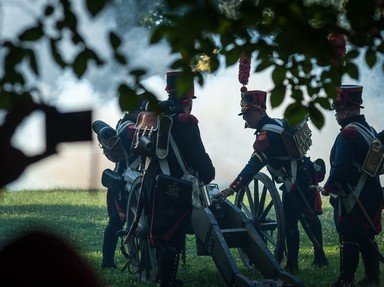Quiz Answer Key and Fun Facts
1. Which country has these uniforms? The infantry coats are predominantly white or undyed wool, the cavalry the same or dark green, and the artillery are in brown.
2. What is the usual English name in this period for the differently-coloured collar or cuffs that turnbacks worn on coats to identify individual regiments within an army?
3. What colour unites the Saxon Cuirassier regiments, the Wurttemberg Guard du Corps, the Spanish Dragoons, and the Swiss infantry battalion of Neuchatel?
4. The infantry of which Napoleonic ally from Germany wore powder-blue uniforms and carried flags with a distinctive sky blue and white lozenge pattern?
5. All infantry regiments of the British Army wore red coats.
6. Up until the 1807 invasion by the French, what was the most common type of hat to be seen in the Spanish Army?
7. Across the Atlantic, the USA and the UK were at war too. What were the two predominant coat colours of the young US Army?
8. This ally of Great Britain kept a small force between 1809 and 1815, when they played a much bigger role as one of the component Allied armies in the Waterloo Campaign. Their uniform was black for all arms except riflemen and artillery drivers; where did they come from?
9. Napoleon had two Lancer regiments in his Imperial Guard; one was Polish and wore blue uniforms, the second wore red and came from which country?
10. While on the subject of Napoleon's Guard, his Guard Chasseurs-a-Cheval regiment had a squadron with a distinctly oriental look about them. How were they described?
Source: Author
spaceowl
This quiz was reviewed by FunTrivia editor
ponycargirl before going online.
Any errors found in FunTrivia content are routinely corrected through our feedback system.
